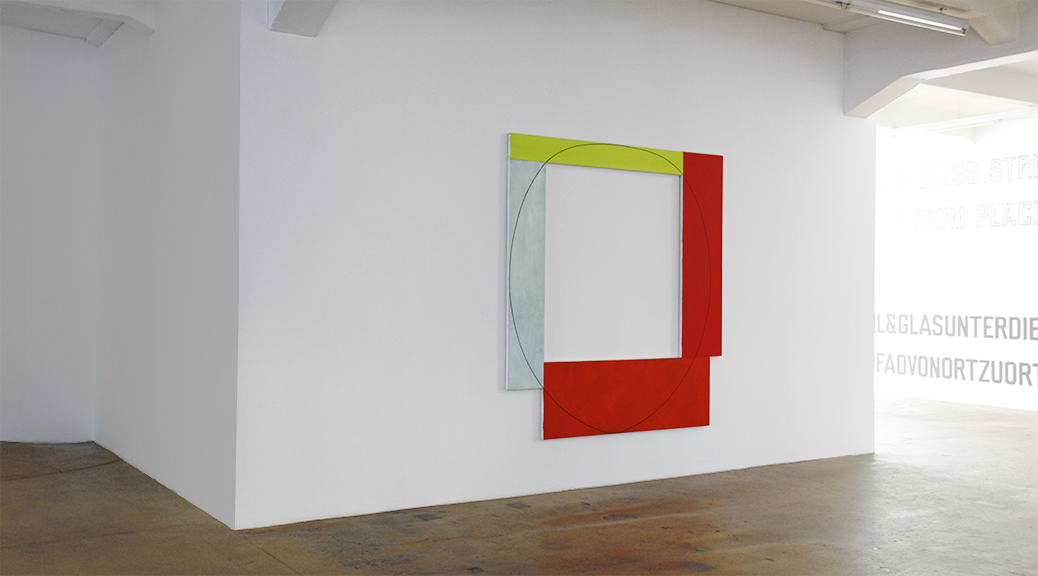Robert Mangold
Four Color Frame Painting #7 (yellow-green, red, red-orange, light blue), 1984
Unsere Vorstellung von einem Gemälde orientiert sich gewöhnlich an der Tradition, und das traditionelle Bild ist in der Regel so aufgebaut, dass der wichtigste Teil sein Zentrum ist. Hier spielt sich das wesentliche Geschehen ab, hier wird die Darstellung ins richtige Licht gerückt, und hierhin wird der Blick der Betrachter gelenkt.
Nichts davon findet sich bei einem Mangold-Werk wie diesem. Man kann nicht einmal von einem Bild sprechen, denn es gibt keine Darstellung von etwas. Und vor allem: das Zentrum ist offen und zeigt nichts anderes als die weisse Wand. Und doch haben wir ein Gemälde von grosser Intensität und Ausstrahlung vor uns. Es verfügt über so viel Energie, dass seine Oberfläche uns physisch entgegenkommt. Die gesamte Wand reagiert dynamisch und lässt keinen Zweifel, dass sie voll in die Wirkung einbezogen ist. Die vier aneinander montierten Farbfelder des „Four Color Frame“ erzeugen in Verbindung mit dem Raum eine Spannung, die auf die Betrachter übergreift. Hier findet also das Geschehen statt – ausserhalb des Gemäldes, doch ausgelöst durch dessen Beschaffenheit und Qualität.
Was hat Mangold gemacht? Er hat vier längliche Rechtecke von unterschiedlicher Breite jeweils ganz mit einer Farbe bemalt und dafür eine ziemlich ungewöhnliche Kombination von Tönen benutzt. Die Teile sind rückwärtig zu einem rechtwinkligen „Rahmen“ verschraubt. Vorne werden sie von einer ovalen Graphitlinie zusammengebunden, die alle Flächen durchläuft und wie der Farbauftrag in Schichten aufgebaut ist. Das Ganze ist bei aller Rauheit von grösster Präzision; allein schon der Verlauf der von Hand gezeichneten Linie verdient es, sehr genau betrachtet zu werden. Überhaupt ist dieses Werk in seiner Konzeption wie in der Ausführung eine Herausforderung an die Wahrnehmung – Ausdruck und Auslöser eines Vorgangs, der Intelligenz mit Emotion auflädt.
Eine Fotostrecke von Mangold-Installationen in den Raussmüller Hallen, Basel und den Hallen für Neue Kunst, Schaffhausen finden Sie auf unserer online Plattform Raussmüller Insights. Einen aufschlussreichen Text von Christel Sauer zu dem Werk finden Sie in unserer Publikation Three Works by Robert Mangold (2011).Robert Mangold
Four Color Frame Painting #7 (yellow-green, red, red-orange, light blue), 1984
Our idea of a painting is usually based on tradition, and as a rule a traditional painting is constructed so that the most important part is at its center. This is where the essential events occur, the representation is highlighted and the observer’s eye is directed.
Nothing of the above can be found in a Mangold work like this one. One can’t even speak of a picture, since nothing is represented. And above all: the center is open and shows nothing other than a white wall. But we still have a painting of great intensity and radiance in front of us. It has so much energy that its surface reaches out to us in a physical way. The entire wall reacts dynamically and leaves no doubt that it is fully integrated into the effect. The four color fields of the “Four Color Frame”, mounted along their edges, create a tension in connection with the space that transmits itself onto the observer. This is where the event takes place – outside of the painting, but still caused by its properties and quality.
What did Mangold do? He painted each of four rectangles in different widths with a unique color and used rather unusual combinations in hues. The parts are screwed together in the rear to form a square “frame”. They are joined together in the front with an oval graphite line that crosses through all surfaces and is applied in layers the same way color is. Despite its raw character, the whole is of utmost precision; the stroke of the line, drawn by hand, deserves close observation. In fact, this work’s concept as well as realization is a challenge to perception – the expression and trigger for a process that charges intelligence with emotion.
See more Mangold installations in the Raussmüller Hallen, Basel and the Hallen für Neue Kunst, Schaffhausen in a series of photographs on our online platform Raussmüller Insights. We have also published an insightful text by Christel Sauer on this work in our publication Three Works by Robert Mangold (2011).
